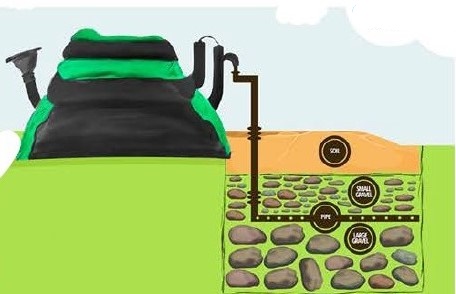- Forum
- categories
- Sanitation systems
- Treatment of wastewater, sludges, organic waste, excreta
- Septic tanks (conventional or upgraded)
- Experts weigh-in on the septic tank vs biodigester debate (FINISH Mondial technical sanitation experts) / biogas reactors
Experts weigh-in on the septic tank vs biodigester debate (FINISH Mondial technical sanitation experts) / biogas reactors
19.2k views
- hajo
-

- retired in Germany... but still interested in water and sanitation... especially in OSS... and especially in Africa...
Less- Posts: 288
- Karma: 15
- Likes received: 156
Re: Experts weigh-in on the septic tank vs biodigester debate (FINISH Mondial technical sanitation experts)
I think this paragraph needs to be printed in bold and underlined so that everybody considering using a biodigester makes her/himself aware of the necessary O&M which is only worthwhile at institutions where someone is employed doing the maintenance and the recovered gas has an economic value (saving energy for cooking in the kitchen of the institution).As for the original topic:
I believe that unless you have a large & low-cost commercial support infrastructure (and a few other beneficial factors such as livestock ownership etc.) it is unrealistic to have household owned and operated biogas digesters. It might work in institutional settings or for housing complexes, but only if the produced gas provides significant economic incentive as opposed to just a "nice thing to have".
ciao
Hajo
Albert Einstein
Any intelligent fool can make things bigger and more complex... It takes a touch of a genius - and a lot of courage to move in the opposite direction.
E.F. Schumacher
Everything should be made as simple as possible, but not simpler.
Albert Einstein
Please Log in to join the conversation.
You need to login to replyRe: Experts weigh-in on the septic tank vs biodigester debate (FINISH Mondial technical sanitation experts)
Mayor610 wrote: A bio-digester requires ten times the volume of a septic tank, is incorrect.
I think a lot of misunderstandings around this arise from the fact that standard design parameters found in most literature for septic-tanks are based on the (global north) assumption that septic-tanks are always also meant to capture most if not all of the grey-water of a household (that is connected to a 24/7 piped water supply). This makes most comparisons to domestic biogas design parameters invalid and is also an unrealistic assumption for most of the world.
As for the original topic:
I believe that unless you have a large & low-cost commercial support infrastructure (and a few other beneficial factors such as livestock ownership etc.) it is unrealistic to have household owned and operated biogas digesters. It might work in institutional settings or for housing complexes, but only if the produced gas provides significant economic incentive as opposed to just a "nice thing to have".
Septic-tanks have a longer term emptying problem, but from my experience having overseen the construction of a few thousand of them in post-emergency transitional settings, it is a technology that is mostly affordable and resilient to unfavorable conditions. Sure, I agree with much what the critics say about them, but ultimately what counts is the feasibility at scale under "real-world" conditions.
Please Log in to join the conversation.
You need to login to reply- Mayor610
-

- Water Supply & Sanitation Specialist
Less- Posts: 11
- Likes received: 2
Re: Experts weigh-in on the septic tank vs biodigester debate (FINISH Mondial technical sanitation experts)
It is really a very pertinent topic for household/community sewage treatment for Low income group countries.
I will go in for Bio-digester provided with a robust , foolproof & safe system to tap bio-gas to meet daily requirement of fuel for cooking purpose by a household.
A bio-digester requires ten times the volume of a septic tank, is incorrect.Arrangement for overflow pipe for emptying the excessive liquid content in a Soakage pit can be made so as to retain the solids to the extent possible for anaerobic digestion.Slurry outlet is also provided for regularly taking it out.
Frequent cleaning of Bio-digester is not at all required because sludge generated is roughly 1 cm thick per annum for a group of households/community toilet upto 100 usages/day.
For regeneration purpose , the activated carbon of biogas filter is replaced every six months.
The only constraint that I see in this small size Bio-digester[ connected to 100 usages /day community toilet] is that the household where you would like to provide bio-gas connection should not be more than 6-7 m away as quantity of bio-gas produced is small to meet 2 hours of cooking per day.
Another point that you have to cater is the secondary treatment & disposal of supernatant liquor obtained from the Bio-digester by means of, preferably VFCW which is completely odourless.
Lastly since this an era to conserve energy and to bring down the cost of fuel for poor households ----this is the solution. Governments should provide bio-digesters at least for community toilets .
With regards,
Mayor Kumar
Water Supply & Sanitation Specialist
DED Consultants
Dili
Timor Leste
Attachments:
-
 Biodigester-1.jpg
(Filesize: 859KB)
Biodigester-1.jpg
(Filesize: 859KB)
-
 Biodigester-2.jpg
(Filesize: 861KB)
Biodigester-2.jpg
(Filesize: 861KB)
Please Log in to join the conversation.
You need to login to reply- Elisabeth
-
- User is blocked
- Freelance consultant since 2012
Less- Posts: 3372
- Karma: 54
- Likes received: 932
Re: Experts weigh-in on the septic tank vs biodigester debate (FINISH Mondial technical sanitation experts) / biogas reactors
I tend to agree with Pawan that a direct side-by-side comparison of the two is probably not so valid because the biodigester would always need more organic matter inputs than just blackwater to function properly.
We had a similar discussion on the forum here which was called " Regular septic tanks vs biodigester septic tanks ".
If I understood right, there the "biodigester septic tanks" were different again to biodigesters and were not producing biogas.
(isn't it annoying to see all these similar terms floating around which can really confuse us; some people use biodigester for an aerobic process, some for an anaerobic process; some for biogas production, some for no biogas).
Lauren: wouldn't your discussion perhaps been better entitled "septic tank versus biogas reactor debate"? Just wondering.
Also you mentioned your social media channels for further discussion and provided a link to your LinkedIn account. I am just wondering about your experiences with discussions on social media: do they work? Are they vibrant? Are they searchable later?
I find it an interesting concept, and we have also discussed it here with regards to "is it a competition to this forum, or how can we harness synergies?".
Regards,
Elisabeth
Freelance consultant on environmental and climate projects
Please Log in to join the conversation.
You need to login to replyRe: Experts weigh-in on the septic tank vs biodigester debate (FINISH Mondial technical sanitation experts)
Objectives of Septic tank and Biogas digester are quite different- former is for treatment of black water and the later for biogas generation from wastes. Toilet linked septic tank is applicable for any household whereas toilet linked biogas plant is applicable only where cattle dung is also available as feed material for biogas generation. Toilet linked biogas plant fed only with human wastes is never economically feasible as biogas production rate per user of toilet per day is only one cubic foot, i.e., from a family of 5 users, only 5 cu ft gas is produced per day. A 25 kg of cattle dung is required for one cum of biogas. However, when linked with toilet, only 17-18 kg of dung is required for the same volume of biogas . There is additive effect on biogas generation from cattle dung when linked with toilet.
For a household, a toilet linked biogas plant having required quantity of cattle dung, is perhaps the only sanitation technology where CAPEX of the system can be recovered within 4-5 years. Life of the system may be more than 40-50 years as the structure is RCC ( Reinforce Cement Concrete) structure. Monthly expense of LPG ( in India INR 700, i,e., 9 US$) can be totally saved by using biogas for cooking.
In case of Septic tank, treatment of effluent is required for its safe disposal. Further, treatment of septage from the tank for its safe reuse or disposal remains a huge task. Similar is the case with biogas plant also. Proper treatment of septage is required. However, treatment of septage from biogas plant is much easier than septic tank. In case of septic tank, mechanical emptying of septage from tanks is costly and its further treatment is expensive. It can't be done individually. In case of biogas plant septage flows into slurry chamber under gravity and there is no extra cost. It can be treated at household level.
One needs to check the detail matrix of the two systems before concluding the best one.
Further, there is better technology like ABR. Performance of ABR is much better than Septic tank with slightly higher cost. One should implement this technology where biogas plant is not feasible.
Regards
Pawan
Chairman
Foundation for Environment and Sanitation
Mahavir Enclave
New Delhi 110045, India
Web: www.foundation4es.org
Linked: linkedin.com/in/drpkjha
Please Log in to join the conversation.
You need to login to reply- lpope
-
 Topic Author
Topic Author- Sanitation business adviser, working on linkages between the circular sanitation economy and agriculture at WASTE & FINISH Mondial programme (TA Uganda)
Less- Posts: 1
- Likes received: 0
Experts weigh-in on the septic tank vs biodigester debate (FINISH Mondial technical sanitation experts)
I invite you to join our debate on the best household sanitation technologies. Some of our technical experts have written down some thoughts on a septic tank vs biodigester debate. We would love to know what you think!
Full article here:
finishmondial.org/sanitation-technology-debate/
Plain text following:
Ecosans, Aberloos, toilet-linked biogas biodigesters…A great debate wages on in the sanitation sector, each technology and modification striving to be the next great innovation for mass uptake. When it comes down to on-the-ground efficacy however, what are the actual technologies that sanitation experts rely on for sustainable designs?
Generally, one would be hard pressed to find a practitioner in the sanitation field ‘singing the praises’ of the traditional septic tank. Why is this? The FINISH Mondial (FM) Technical Working Group (TWG) set out to settle the matter: Is the septic tank really an archaic, useless technology? Or perhaps, is there simply a fascination with newer, shinier product innovations today?
The TWG supports FINISH Mondial by uniting our key technical experts across 3 continents, to support the entire 6-country programme in:
- Developing technical construction manuals for on-site sanitation systems,
- Institutionalising mason/artisan trainings in various countries, and
- Learning and sharing innovations in design, construction and rehabilitation of sanitation systems considering the possible reuse of faecal sludge.
We asked some of our FINISH Mondial Technical Experts to weigh in on two prominent ends of the debate spectrum. Which are their preferred systems to implement? The SEPTIC TANK or BIODIGESTER (considering no harvest of the biogas):
G. Anand, Solutions Centre (India) – easy &reliable
Septic Tanks would be my first choice since they are(a)easy to manage with lower frequency of cleaning, (b) is flexible in handling hydraulic and organic load variations, and(c) is generally less affected by fugitive solid wastes than, for example, a biodigester.
Both septic tanks and biodigesters have issues regarding disposal and reuse of the collected matter. In twin leach pits, we can get it in a dry form which is easier to handle, dispose and reuse. Septic Tanks yield sludge or septage which needs further de-watering. Our model of co-composting may not necessarily be practicable in all contexts. However, when you have potential for water pollution, septic tanks are better than leach pits since the discharge from is partially treated unlike the leach pit, where only untreated effluent is discharged in the environment.
John Harrison, FINISH Mondial Technical Adviser(South Africa) – tried & tested solution
A septic tank is a tried and tested, simple solution, also ideal for African conditions if designed and installed correctly. Biodigesters only make sense if one intends on harvesting the gas, but then you require additional biomass as fuel, which in turn will probably increase the frequency of emptying. If the gas is not being harvested, then a circular reactor does not make any sense as you are either adding significant complexity, and/or creating significant short-circuiting, and/or require significant extra wasted volume in the reactor to achieve the equivalent actual residence time. In short, I see no point in going down the route of biogas reactors if the gas won’t be harvested—making the device suitable for harvesting the gas makes it less efficient as a sanitation system. A biodigester is primarily a gas harvesting device not a sanitation system.
Saurabh Agnihotri, FINISH Society (India) – largely unsuccessful for high density areas
Technologies like biodigesters can be instrumental, particularly in places where households cannot afford standalone treatment and community-linkages can be explored, especially in areas where septic tanks may not be feasible. In the Indian context, septic tanks have been largely unsuccessful, especially regarding emptying them in areas which are densely populated. We often face challenges in some communities where it is not viable to link this with one tank. Several toilets can be linked to this kind of system as large septic tanks are not often feasible and do not function properly.
It is worth noting that for septic tanks, the issue of black water discharge is concerning. If we can identify the best solutions to combine with other systems, we may be able to recycle the water which is also instrumental in low water table areas. In my view, we must increasingly give more weight to technologies which consume less water or are water-positive in nature.
Henock Belete Asfaw, WASTE (Netherlands, Ethiopia) – cost & environmental implications
An important aspect necessary to evaluate septic tanks vs biodigesters is the investment required by households. The construction costs of septic tanks and biodigesters can be evaluated by considering the typical hydraulic retention times (HRT). HRT is the average amount of time a daily wastewater inflow spends in the tank. Typical HRTs of septic tanks and biodigesters are 2 and 20 days respectively, meaning that tank sizes of biodigestersare about 10x bigger than septic systems. For example, if a household generates an average daily wastewater flow of 1m3, a septic tank size of 2m3 is required, while a 20m3 tank size would be required for a biodigester. This implies the construction cost of a biodigester is significantly higher than a septic system.
Domestic wastewater has low bio-degradable organic matter, meaning the biogas produced by an expensive biodigester is very little. In addition, when the biogas is not harvested and used, which is the case here, biodigesters become a system that significantly pollutes the environment since methane is 30X more potent than CO2. In general, a biodigester system, where biogas is not captured and used (or atleast burned), suggests the technology does not align with FINISH Mondial’s philosophy, which prioritizes affordability and access but not at the cost of circular economy and climate resilience (considering methane is 30x more potent than CO2).
Where do you stand on this debate? You can join the conversation below or on our social media pages where our technical experts can answer any questions.
www.linkedin.com/showcase/finish-mondial/
Please Log in to join the conversation.
You need to login to reply- Forum
- categories
- Sanitation systems
- Treatment of wastewater, sludges, organic waste, excreta
- Septic tanks (conventional or upgraded)
- Experts weigh-in on the septic tank vs biodigester debate (FINISH Mondial technical sanitation experts) / biogas reactors








